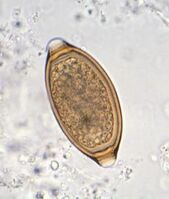Laurie Anne Walden, DVM  Whipworms are intestinal parasites that are relatively common in dogs and can cause serious illness. Some (not all) monthly heartworm preventives prevent whipworm infection. Canine whipworms are small worms about 2 to 3 inches long that live in the cecum, a pouchlike structure attached to the large intestine. The whipworm that infects dogs, Trichuris vulpis, does not infect humans. (Another species of whipworm can infect people.) Whipworms are very rare in cats in North America. According to the Companion Animal Parasite Council (CAPC), almost 50,000 dogs in the United States tested positive for whipworms in 2019. About 2500 of these dogs were in North Carolina, putting North Carolina in the CAPC high-risk category for whipworms.[1] Transmission Dogs are infected with whipworms when they swallow whipworm eggs in the environment—for example, by licking dirt from their feet.[2] The eggs hatch in the dog’s intestines and grow to adult worms in the cecum. About 2.5 to 3 months after the dog is infected, the adult worms begin producing eggs that pass out of the body in the feces. Whipworm eggs in the environment take about 2 to 3 weeks (or longer) to develop into a stage that can infect dogs. This means that dogs are infected by swallowing contaminated substances, not by eating fresh dog poop. Whipworm eggs in the environment are resistant to temperature changes and sunlight and are able to infect dogs for years.[3] Symptoms Symptoms of whipworm infection depend partly on the number of worms present and can include the following:
Diagnosis Whipworm infection can be a little tricky to diagnose. Typical fecal analysis at a veterinary clinic involves looking for worm eggs in a stool sample under a microscope. However, because whipworms don’t produce eggs for the first few months after infection and they don’t produce eggs all of the time, stool analysis with a microscope can miss the infection. Sending a fecal sample to a diagnostic laboratory for a whipworm antigen test can increase the chance of finding the infection. Treatment and Prevention Antiparasitic drugs to treat whipworm infection are typically given in at least 2 doses spaced a few weeks apart. Monthly heartworm preventives that contain milbemycin (given by mouth) or moxidectin (applied to the skin) will treat and prevent whipworm infection.[3] Other heartworm preventives available at the time of writing (May 2020) are not effective against whipworms. It’s not possible to completely eliminate whipworm eggs that are already in the environment. The CAPC recommends reducing dogs’ risk by removing dog feces from the environment and regularly testing dogs for whipworms. References 1. Parasite prevalence map: 2019, whipworm, dog, United States. Companion Animal Parasite Council. Accessed May 20, 2020. https://capcvet.org/maps/#2019/all/whipworm/dog/united-states/ 2. Brooks W. Whipworm infection in dogs and cats. Veterinary Partner. Published May 8, 2004. Updated July 18, 2018. Accessed May 20, 2020. https://veterinarypartner.vin.com/doc/?id=4952061&pid=19239 3. Trichuris vulpis. Companion Animal Parasite Council. Updated October 1, 2016. Accessed May 20, 2020. https://capcvet.org/guidelines/trichuris-vulpis/ Image: photomicrograph of Trichuris vulpis egg, 400× magnification. Credit: CDC/Dr Mae Melvin.
0 Comments
Your comment will be posted after it is approved.
Leave a Reply. |
AuthorLaurie Anne Walden, DVM Categories
All
Archives
June 2024
The contents of this blog are for information only and should not substitute for advice from a veterinarian who has examined the animal. All blog content is copyrighted by Mallard Creek Animal Hospital and may not be copied, reproduced, transmitted, or distributed without permission.
|
- Home
- About
- Our Services
- Our Team
-
Client Education Center
- AKC: Spaying and Neutering your Puppy
- Animal Poison Control
- ASPCA Poisonous Plants
- AVMA: Spaying and Neutering your pet
- Biting Puppies
- Boarding Your Dog
- Caring for the Senior Cat
- Cats and Claws
- FDA warning - Bone treats
- Force Free Alliance of Charlotte Trainers
- Getting your Cat to the Vet - AAFP
- Holiday Hazards
- How To Feed Cats for Good Health
- How to Get the Most Out of your Annual Exam
- Indoor Cat Initiative - OSU
- Introducing Your Dog to Your Baby
- Moving Your Cat to a New Home
- Muzzle Training
- Osteoarthritis Checklist for Cats
- What To Do When You Find a Stray
- Our Online Store
- Dr. Walden's Blog
- Client Center
- Contact
- Cat Enrichment Month 2024
|
Office Hours
Monday through Friday 7:30 am to 6:00 pm
|
Mallard Creek Animal Hospital
2110 Ben Craig Dr. Suite 100
|
Site powered by Weebly. Managed by IDEXX Laboratories

 RSS Feed
RSS Feed